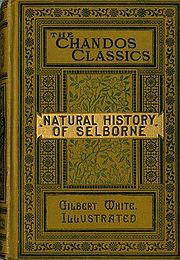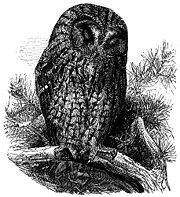
The Natural History and Antiquities of Selborne
Encyclopedia

England
England is a country that is part of the United Kingdom. It shares land borders with Scotland to the north and Wales to the west; the Irish Sea is to the north west, the Celtic Sea to the south west, with the North Sea to the east and the English Channel to the south separating it from continental...
naturalist
Natural history
Natural history is the scientific research of plants or animals, leaning more towards observational rather than experimental methods of study, and encompasses more research published in magazines than in academic journals. Grouped among the natural sciences, natural history is the systematic study...
and ornithologist
Ornithology
Ornithology is a branch of zoology that concerns the study of birds. Several aspects of ornithology differ from related disciplines, due partly to the high visibility and the aesthetic appeal of birds...
Gilbert White
Gilbert White
Gilbert White FRS was a pioneering English naturalist and ornithologist.-Life:White was born in his grandfather's vicarage at Selborne in Hampshire. He was educated at the Holy Ghost School and by a private tutor in Basingstoke before going to Oriel College, Oxford...
first published in 1789. It has been continuously in print since then, with nearly 300 editions up to Thames & Hudson's
Thames & Hudson
Thames & Hudson is a publisher of illustrated books on art, architecture, design, and visual culture. With its headquarters in London, England it has a sister company in New York and subsidiaries in Melbourne, Singapore and Hong Kong...
The Illustrated Natural History of Selborne in 2007.
This book was a compilation of 44 of his letters to Thomas Pennant
Thomas Pennant
Thomas Pennant was a Welsh naturalist and antiquary.The Pennants were a Welsh gentry family from the parish of Whitford, Flintshire, who had built up a modest estate at Bychton by the seventeenth century...
, the leading British zoologist of the day, and 66 letters to the Hon. Daines Barrington
Daines Barrington
Daines Barrington, FRS was an English lawyer, antiquary and naturalist.Barrington was the fourth son of the first Viscount Barrington. He was educated for the profession of the law, and after filling various posts, was appointed a Welsh judge in 1757 and afterwards second justice of Chester...
, an English
England
England is a country that is part of the United Kingdom. It shares land borders with Scotland to the north and Wales to the west; the Irish Sea is to the north west, the Celtic Sea to the south west, with the North Sea to the east and the English Channel to the south separating it from continental...
barrister
Barrister
A barrister is a member of one of the two classes of lawyer found in many common law jurisdictions with split legal professions. Barristers specialise in courtroom advocacy, drafting legal pleadings and giving expert legal opinions...
and another Fellow of the Royal Society
Royal Society
The Royal Society of London for Improving Natural Knowledge, known simply as the Royal Society, is a learned society for science, and is possibly the oldest such society in existence. Founded in November 1660, it was granted a Royal Charter by King Charles II as the "Royal Society of London"...
. In these letters White detailed the natural history of the area around his family home at the vicarage of Selborne
Selborne
Selborne is a village in the East Hampshire district of Hampshire, England. It is south of Alton. It will be just within the extreme northern boundary of the proposed South Downs National Park, which is due to take effect in mid-2010....
in Hampshire
Hampshire
Hampshire is a county on the southern coast of England in the United Kingdom. The county town of Hampshire is Winchester, a historic cathedral city that was once the capital of England. Hampshire is notable for housing the original birthplaces of the Royal Navy, British Army, and Royal Air Force...
.

Folklore
Folklore consists of legends, music, oral history, proverbs, jokes, popular beliefs, fairy tales and customs that are the traditions of a culture, subculture, or group. It is also the set of practices through which those expressive genres are shared. The study of folklore is sometimes called...
and common knowledge
Common knowledge
Common knowledge is knowledge that is known by everyone or nearly everyone, usually with reference to the community in which the term is used. Common knowledge need not concern one specific subject, e.g., science or history. Rather, common knowledge can be about a broad range of subjects, including...
. For example, he realized that there were not one but three British species of "willow-wren" (leaf-warblers) which are now known as the Chiffchaff
Chiffchaff
The Common Chiffchaff, or simply the Chiffchaff, is a common and widespread leaf-warbler which breeds in open woodlands throughout northern and temperate Europe and Asia....
, Willow Warbler
Willow Warbler
The Willow Warbler is a very common and widespread leaf warbler which breeds throughout northern and temperate Europe and Asia, from Ireland east to the Anadyr River basin in eastern Siberia...
and Wood Warbler
Wood Warbler
The Wood Warbler is a common and widespread leaf warbler which breeds throughout northern and temperate Europe, and just into the extreme west of Asia in the southern Ural Mountains...
. He also described the Common Noctule
Common Noctule
The Common Noctule is a species of bat common throughout Europe, Asia, and North Africa. The UK distribution can be found on the National Biodiversity Network website ....
, Harvest Mouse
Harvest Mouse
The Harvest Mouse, Micromys minutus, is a small rodent native to Europe and Asia. It is typically found in fields of cereal crops such as wheat and oats, in reed beds and in other tall ground vegetation such as long grass and hedgerows. It has reddish-brown fur with white underparts and a naked,...
and Lesser Whitethroat
Lesser Whitethroat
The Lesser Whitethroat is a common and widespread typical warbler which breeds in temperate Europe, except the southwest, and in western and central Asia. This small passerine bird is strongly migratory, wintering in Africa just south of the Sahara, Arabia and India.Unlike many typical warblers,...
, and studied the habits of the Stone Curlew
Stone Curlew
The Stone Curlew, Eurasian Thick-knee, or Eurasian Stone-curlew Burhinus oedicnemus is a northern species of the Burhinidae bird family....
, Nightjar
European Nightjar
The European Nightjar, or just Nightjar, Caprimulgus europaeus, is the only representative of the nightjar family of birds in most of Europe and temperate Asia.- Habitat and distribution :...
, Swallow
Barn Swallow
The Barn Swallow is the most widespread species of swallow in the world. It is a distinctive passerine bird with blue upperparts, a long, deeply forked tail and curved, pointed wings. It is found in Europe, Asia, Africa and the Americas...
, House Martin
House Martin
The Common House Martin , sometimes called the Northern House Martin or, particularly in Europe, just House Martin, is a migratory passerine bird of the swallow family which breeds in Europe, north Africa and temperate Asia; and winters in sub-Saharan Africa and tropical Asia...
and Common Swift
Common Swift
The Common Swift is a small bird, superficially similar to the Barn Swallow or House Martin. It is, however, completely unrelated to those passerine species, since swifts are in the separate order Apodiformes...
.
One of his few errors paradoxically arises from his meticulous observation. Because Swallows and House Martins were seen so late in the year, often into November, he was convinced that at least some must hibernate
Hibernation
Hibernation is a state of inactivity and metabolic depression in animals, characterized by lower body temperature, slower breathing, and lower metabolic rate. Hibernating animals conserve food, especially during winter when food supplies are limited, tapping energy reserves, body fat, at a slow rate...
through the winter rather than migrate
Bird migration
Bird migration is the regular seasonal journey undertaken by many species of birds. Bird movements include those made in response to changes in food availability, habitat or weather. Sometimes, journeys are not termed "true migration" because they are irregular or in only one direction...
.
White's work means that he is regarded by many as an early ecologist. His book’s attraction derives not only from its scientific value, but from its style and atmosphere; as British ornithologist James Fisher
James Fisher
James Maxwell McConnell Fisher was a British author, editor, broadcaster, naturalist and ornithologist...
wrote in 1941:
His world is round and simple and complete; the British country; the perfect escape.
Though the work is regarded as an inspired close study of a small landscape as seen through the Enlightenment
Age of Enlightenment
The Age of Enlightenment was an elite cultural movement of intellectuals in 18th century Europe that sought to mobilize the power of reason in order to reform society and advance knowledge. It promoted intellectual interchange and opposed intolerance and abuses in church and state...
ideal of the economy of nature, White's work closes with his observations of strange weather following the Laki
Laki
Łąki may refer to the following places in Poland:*Łąki, Lower Silesian Voivodeship *Łąki, West Pomeranian Voivodeship *Łąki, Lublin Voivodeship...
volcano eruption in 1783. He notes the anomalous events of blood-red sunsets caused by scattering from particulate matter and a particularly cold winter into 1784.

